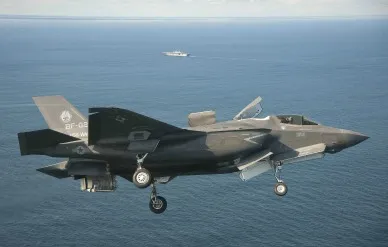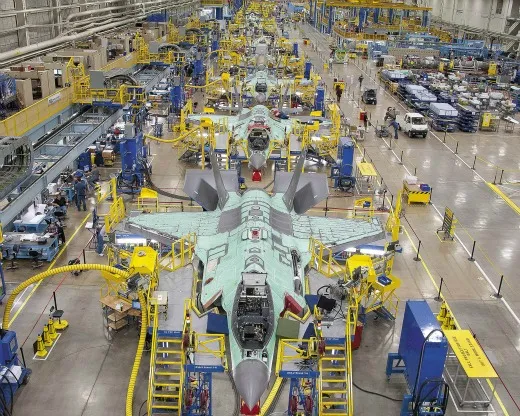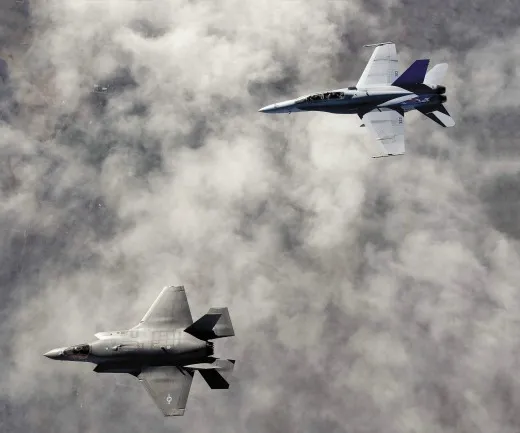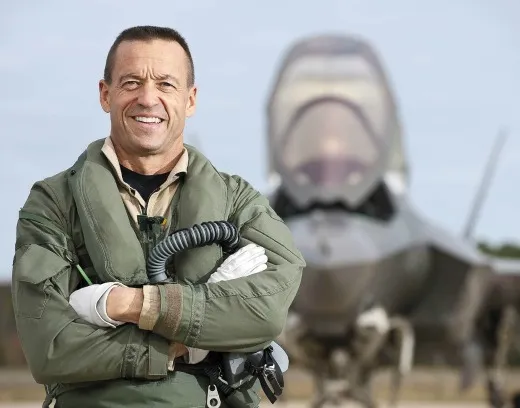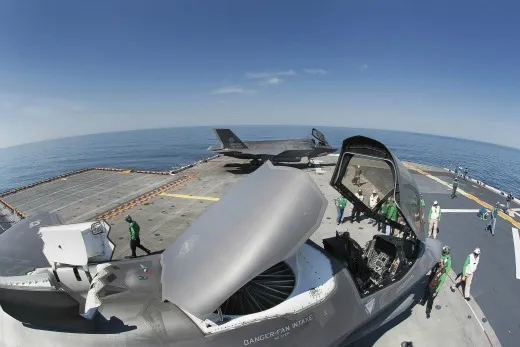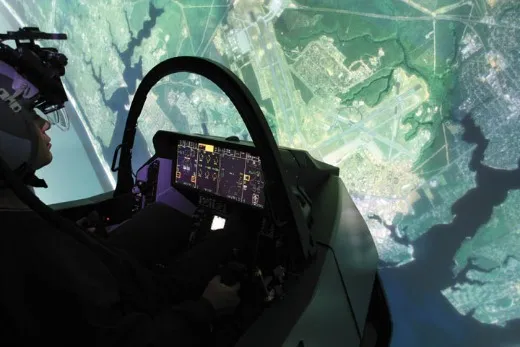The Ultimate Fighter?
With the F-35, Lockheed Martin takes a turn trying to make one combat plane that can do everything.
/https://tf-cmsv2-smithsonianmag-media.s3.amazonaws.com/filer/20120813_ultimatefighter_flash.jpg)
In 1983, an aerospace industry superstar facetiously envisioned where the inexorably climbing cost of building fighter airplanes was leading—to what in a sense would be the ultimate fighter.
“In the year 2054,” Norman R. Augustine wrote in his book Augustine’s Laws, “the entire defense budget will purchase just one aircraft. This aircraft will have to be shared by the Air Force and Navy 3 1/2 days each week, except for leap year, when it will be made available to the Marines for the extra day.”
Today, on a mile-long assembly line in a factory just west of Fort Worth, Texas, the company Augustine ran as chairman and chief executive before he retired in 1996, Lockheed Martin Corporation, is producing an ultimate fighter of a different sort. In just a few more years, and continuing well past 2054, not only the U.S. Air Force, Navy, and Marines but also the militaries of 10 U.S. allies will fly the new F-35 Lightning II, also known as the Joint Strike Fighter. But they won’t have to share just one. Over the next quarter-century, Lockheed and its subcontractors, which span the globe, anticipate building 3,000 or more F-35s—in three different versions.
All three F-35 variants are built for the same primary mission: dropping bombs on or firing missiles at ground targets, especially those so well-defended it takes a radar-evading stealth aircraft to get at them. By virtue of its stealth—and its supersonic speed and staggering computer power—the Lightning II has earned the classification “fifth-generation fighter.” F-35A, B, and C employ the latest in stealth technology, from the slab-sided shape of their bodies to the canted vertical tails to the new type of low-observable coating that covers areas of their skins. Designers cloaked the airplanes’ engines with radar beam-swallowing inlets and buried antennas in the edges of tails and wings. Because of these features and because weapons are ordinarily carried in internal bays, the F-35s appear on radar screens as transient specks. All three carry an identical suite of “mission systems,” including sophisticated radar and infrared video cameras, laser targeting systems to guide weapons, and laser data links for silently sharing imagery and information with other airplanes and ground forces.
Lockheed estimates that when the program reaches peak production, each airplane will cost $65 million; when all research, development, and testing costs are added in, the figure rises to $156 million, according to a 2011 estimate by the U.S. Government Accountability Office. When the contract was awarded in the early 1990s, Pentagon leaders had hoped that by merging multiple fighter projects into a single huge one, they could use mass production to get U.S. services and allies the most advanced strike jet possible for a price that, if far from inexpensive, was at least affordable.
“We’re going to save money in production because Henry Ford had it right,” promises engineer Larry Lawson, executive vice president and, until a recent promotion, general manager for the F-35 program at Lockheed Fort Worth. “The cost is tied to the numbers that you build.”
Operating jet fighters can never be called “cheap,” but with multiple allies flying the same aircraft, and thus able to share facilities and equipment, the cost of operating the F-35 would be cheaper than operating the various “legacy” aircraft, such as the F-16s and AV-8B Harriers, that the new fighter is intended to replace. “We all show up tomorrow with the same kit,” says Lieutenant General André Deschamps, chief of Canada’s air staff, “the same software, same everything. The procedures are the same, the training’s the same. You don’t need to bring all the equipment. We can quickly come together with fewer platforms and have a far greater effect.”
The cornerstone concept of the F-35 program—that an airplane can cost a lot less to build and operate if it’s made for multiple customers and in larger numbers—has been around at least since the 1960s. It’s also enjoyed little success. In the Kennedy administration, Secretary of Defense Robert McNamara failed to make the Air Force and Navy jointly buy the F-111 Aardvark, a swing-wing jet primarily designed to carry nuclear bombs past Soviet air defenses at low altitude and supersonic speed. In the 1970s, the same services again resisted pressure to develop a common fighter. The Air Force bought the F-16 Fighting Falcon; the Navy, the F/A-18 Hornet. The Marine Corps, whose budget falls under the Department of the Navy, bought Hornets too, but also insisted on purchasing the near-experimental AV-8A Harrier, whose ability to take off and land vertically seduced Marine leaders. In short, joint aircraft programs have largely failed because each branch of the military has its own priorities and culture. (The exception that proves the rule, the McDonnell F-4 Phantom II, was not jointly developed by all U.S. flying services, but served with all—as well as with the air forces of 16 other nations.)
In the early 1990s, though, after years of careful study, Pentagon leaders decided to try a joint program once more, but with a twist. The result, after a competition that lasted seven years and left Lockheed the only U.S. defense contractor still making fighters, is essentially fraternal triplets—three aircraft that look much the same and have enough common or similar parts and equipment to be built on the same production line and share the designation “F-35,” yet differ enough to suit the varying needs of the Air Force, Navy, Marines, and allies.
Creating the ultimate multi-mission aircraft is not the only audacious goal of the F-35 program. Lockheed Martin and engine designer Pratt & Whitney are also introducing a propulsion system that gives the B model the ability to take off within far less than the 800-foot length of an amphibious assault ship’s flight deck and hover above it before landing vertically—the feature the Marine Corps most wants. Dozens of schemes to make aircraft capable of short takeoff and vertical landing have been tried and failed; they populate a colorful STOVL diagram, “The Wheel of Misfortune” (vstol.org/wheel.htm). The Harrier, for instance, uses four thrust- vectoring nozzles to aim its jet engine’s exhaust down for vertical flight. The F-35B relies on a new and ingenious mechanism called a lift fan, patented by Lockheed engineer Paul Belivaqua, that offers major advantages.
Contained in an oil-drum-like cavity about 53 inches in diameter and located behind the cockpit, the lift fan consists of two counter-rotating blades connected to a right-angle gearbox and a clutch, which connects through a driveshaft to the F-35’s 40,000-pound-thrust Pratt & Whitney F135 engine. When the pilot, flying at less than 130 mph, pushes a button labeled HOOK/STOVL—the same button drops the F-35C’s tailhook or the F-35A’s emergency landing hook—the airplane transforms itself. (Watch it on YouTube: As it prepares to lift off or land, the F-35B looks like the 1980s transformer toys that shifted their parts to change identities.) Doors in the fuselage above and below the lift fan open simultaneously. The engine’s nozzle swivels to direct its exhaust down. The clutch engages the driveshaft, which spins the fan’s blades. Now the F-35B can hover or land on two columns of air, one hot, one cold (by thermodynamic standards), and each moving fast enough to provide about 18,000 pounds of lift. Two far smaller streams of exhaust funnel down ducts to a small nozzle under each wing called a roll post, providing roughly 2,000 more pounds of lift apiece plus side-to-side balance and control. Unlike the Harrier, whose pilot has to manipulate the aircraft’s stick, throttle, and controls to swivel the nozzles by hand, the F-35B has flight control computers to do all the work of balancing the airplane atop its thrust.
Part of the lift fan’s genius is that it allowed designers to put the F-35’s engine at its rear, the best placement in a non-STOVL aircraft as well, says Paul Park, who left Lockheed last year after three decades but previously led the team of engineers who determined the outer shape, internal arrangement, and other major aspects of the F-35. Having two equally powerful columns of vertical thrust is yet another big advantage in a STOVL plane, Park adds, for in designing such an aircraft, “the number-one challenge is not just the lift, it’s getting the vertical lift balanced around the weight.” That’s why the Harrier’s engine is in the center of the fuselage, he says. The cool air coming from the F-35B’s lift fan also “shields people around the airplane from the hot exhaust in the back,” Park says, and helps prevent the engine from ingesting its hot exhaust, which could cause it to stall.
The F-35B has a smaller wing because weight is an overriding issue for STOVL aircraft, which during landing have to produce at least a pound of thrust for each pound they weigh. The B variant could not afford the extra pounds of a wing-fold mechanism; consequently, its wingspan could be no greater than 35 feet, the maximum width that an amphibious assault ship elevator can accommodate.
Like its predecessors on the Wheel of Misfortune, the F-35 STOVL variant has not been an easy airplane to design. It has been responsible for much of the program’s well-publicized delays, and in January 2011 caused then-defense secretary Robert Gates to put the F-35B on “probation”—an unofficial but damning description—after design problems were found in a bulkhead within its wing and in the propulsion system. By late 2011, after Gates had left office, Lockheed had solved the problems, and last month Secretary Leon Panetta decreed an end to the F-35B’s probationary status. But redemption had come last October, during the variant’s first sea trials, when test pilots performed 72 vertical landings on the USS Wasp amphibious assault ship and took off again from a 400-foot length of the ship’s deck. Among other things, those tests showed that crews could work around the F-35B despite the heat of its aft exhaust. Nor did the exhaust damage the flight deck, as critics had predicted, in part because after landing, the airplane’s engine automatically goes to idle and the nozzle swivels back up.
Given such progress, the Marine Corps commandant, General James Amos, said he was sure his service’s long-awaited STOVL fighter was over its problems. So important to the Marine Corps is the F-35B that Amos had promised the House Armed Services Committee last March that he would be “personally involved with the program and closely supervising it.”
The Marines badly want the F-35B “because of the way we fight,” says John R. “Jack” Dailey, who retired in 1992 as a four-star general after serving as assistant commandant of the Marine Corps. Trained and equipped to invade hostile shores and travel light and fast on land, “the Marine Corps depends on [strike fighters] as our heavy artillery,” explains Dailey, a former fighter pilot who since 2000 has been director of the National Air and Space Museum. The corps wants strike fighters it can base not only on the amphibious assault ships that carry Marines around the globe, but also at austere sites close to the fighting, ideally making it possible to get ground troops close air support within 30 minutes of a call for help. That’s why the Marines bought the Harrier, stuck with it despite a horrific crash rate early in its history, then passed up the chance to buy far more capable conventional fighters in the 1990s while awaiting the F-35B. Dailey is so eager to see the corps get it he bought a vanity license plate that reads “F35STV,” the closest he could come in the space allowed to “F-35 STOVL.”
As different as the STOVL version is from the other F-35s in how it launches and returns, “once they get to the fight, they’re the same,” says Tom Burbage, a former Navy pilot who served as the sole Lockheed manager of the F-35 program from August 2000 until June 2005, when the job was divided and the Fort Worth position Lawson held was created. Now Orlando Carvalho sees to production while Burbage sees to protection—trying to keep the dozens of U.S. and foreign government officials, military officers, and lawmakers with a stake or a say in F-35 decisions informed and on board. “Trying to shepherd the program through all these stakeholders and manage the day-to-day contracts was just too big for one person to do,” Burbage explains.
Keeping the F-35 sold despite its delays and cost overruns has turned out to be what might be called the ultimate challenge, but his personality and background make Burbage suited for the job. At six-foot-four and 220 pounds—a Halloween party costume earned him the radio call sign “Conan” when he was a pilot—he played offensive tackle on the Naval Academy’s football team, so holding the line is an old skill. Burbage flew turboprop E-2 Hawkeye airborne-warning airplanes from carriers in the early 1970s, then became a Navy test pilot. In the Naval Reserve, he flew A-7 attack jets for six years.
Burbage led the company’s F-22 program from 1995 to 1999, taking the Raptor from first flight through initial flight testing. He’d barely settled into his next post, as president of Lockheed’s Marietta, Georgia aircraft plant, when company leaders asked him to head the JSF program. At first, Burbage wasn’t thrilled. With the F-22, he’d had enough long hours and stress to last a lifetime. In the end, he decided he simply couldn’t resist the chance to head up “the biggest thing going” in his line of work: making combat aircraft. Equally important, he adds, was “my pilot brotherhood. I just like being around airplanes, and I like being around guys that fly ’em.”
With nearly innumerable U.S. and international participants, from armed services to government agencies to subcontractors around the globe, the F-35 is one of the most complex projects in the world. Today, by no coincidence, Burbage sits on the board of an Australian organization called the International Centre for Complex Project Management, formed to study why systems engineering tools such as Earned Value Management often prove inadequate in such massive ventures.
Burbage’s approach to the challenge is to nurture personal relationships with as many stakeholders as he can, which means “I spend a lot of time going somewhere and coming back from somewhere.” He jets to and from Washington and around the globe so much, in fact, that he’s racked up more than two million frequent flier miles on American Airlines and Delta both—and doesn’t even fly those carriers on long hauls.
Burbage compares himself to a juggler, then ruefully notes that “the human limit for juggling is 14 objects,” while the armed services he has to deal with alone number 17. Even so, his only real regret seems to be that, because he’s a corporate officer, company policy requires him to retire within a year after he turns 65; that means he must be out by September 2014. One gathers from talking to him that midwifing the births of the F-22 and F-35, two of the most sophisticated flying machines ever built, hasn’t been just a job but a commitment. “I’ve got a lot of my sweat-equity and life and emotion in those two airplanes,” Burbage says.
In fact, it’s been a roller coaster ride. There was the punch to the solar plexus Burbage felt in 2004, when engineers came to tell him company and government weight projections were flawed and the STOVL version of the F-35 was going to be far too heavy to meet its performance requirements. “I didn’t feel like eating much after I heard that,” Burbage recalls. But there was also the emotional high he felt when the first F-35 took flight on December 15, 2006, an event witnessed by thousands of Lockheed employees in Fort Worth. Looking down at the scene from the control tower and listening to test pilot Jon Beasley over the radio as aircraft AA-1 rolled down the runway and rose into the sky, Burbage had a lump in his throat and tears in his eyes. “I want to see this airplane become what I think it can be,” he says.
What the F-35 could be is remarkable, in many ways. The cockpit alone is an engineering marvel and a key difference between the F-35 and fourth-generation fighter aircraft.
The fourth-generation F-16, also built by Lockheed, has a cockpit cluttered with an array of multi-function displays, gauges, and more than 100 switches. A major task for its pilot is to simply absorb and react to—“fuse,” in pilot parlance—the blast of information all those screens and dials produce. The pilot must do this while manipulating dozens of switches to tell the sensors what data to provide next…while frequently looking at the head-up display projected on the windscreen to read numbers and symbols conveying vital information, such as altitude, airspeed, and the location of enemy aircraft…while often turning his head to look up, to the sides, and, to the limited extent possible, behind his airplane…while occasionally talking on one or more radios…while streaking through the sky at hundreds of miles an hour using both hands and both feet to control the aircraft…often while wearing night-vision goggles to fly in darkness.
It keeps a pilot busy.
The F-35 cockpit, designed by a team of ex-military aviators led by former Air Force F-16 pilot Mike Skaff, Lockheed’s chief pilot-vehicle interface engineer, is streamlined. “It’s the most naked cockpit we’ve ever built,” says slender, sharp-featured Skaff, who grins as he shows off his team’s creation.
Its dominant feature is the fighter-jet equivalent of a home theater high-definition TV—two 8- by 10-inch screens, nestled together to form an expansive 8- by 20-inch display that spans the cockpit console. The big screen works something like a smart phone. By touching it with a gloved finger, or by using a button on the airplane’s control stick to move a cursor, or in some cases by simply speaking a command, the pilot can call up and organize flight or mission data, drop bombs, fire missiles, or share information with friendly air or ground forces.
Eric Branyan, who led the Lockheed team developing F-35 mission systems before becoming deputy program manager, sums it up this way: “We take all these sensors, put it on an 8-by-20 piece of glass, and put a God’s-eye view in front of that pilot that says ‘Here’s where all the good guys and the bad guys are. Help the good guys, shoot the bad guys.’ ”
Also important is what the cockpit lacks. There aren’t many switches—only about 25 on the console—and there’s no HUD beneath the canopy. HUD information is shown on the inside of the pilot’s helmet visor, an innovation that lets the flier keep track of life-and-death data no matter which way he turns his head. The helmet itself, built by U.S.-Israeli joint venture Vision Systems International in Silicon Valley, is another fifth-generation wonder. Attached to the airplane by a sapling-size cable, the helmet holds two small projectors just above the pilot’s forehead. Besides HUD data, the devices can project onto the pilot’s visor infrared video images gathered by six other cameras embedded in the skin of the airplane at strategic locations. Quilted together to create a single, 360-degree image, the pictures from this Distributed Aperture System, or DAS (pronounced “dass”), give an F-35 pilot the science fiction capability to scan the sky in any direction—even through the bottom of the airplane. “It’s a lot like flying Wonder Woman’s glass airplane when I use that,” Skaff jokes.
The helmet is still a work in progress. Under some aerodynamic conditions, the display on the pilot’s visor can still get so jittery as to be unreadable, and the imagery the DAS provides isn’t yet up to the standards the government requires for night vision goggles. The DAS imagery also suffers “latency,” or millisecond delays in getting what the cameras see to the visor.
The F-35’s flight control computers, which currently have 8.7 million lines of software code, do most of the flying. When they get flight commands from the pilot, the commands come through a control stick located on the right side of the cockpit and a throttle located on the left, both called “inceptors” because they operate electronically instead of mechanically. Rather than focus on managing sensors or handling the airplane, Skaff says, the F-35 pilot can concentrate on being a combat tactician.
All that makes the F-35 far more than a mere bomb-dropper. But while the aircraft is called a “fighter,” carries air-to-air weapons, and is required by Pentagon specifications to have as much power and maneuverability as each type of aircraft the three variants are to replace, the F-35 isn’t meant to dogfight. Says Burbage: “If you ever get into the ‘phone booth,’ where you’re within visual range, turning to fight with somebody, you’ve screwed up pretty big time, because your sensors and your stealth allow you to stay completely out of that fight. When you’re en route to hit that strategic target and you have an air threat coming your way, you have enough advance warning—you can engage or avoid, depending on what’s required. If you do decide to engage, you can hit them long before they know you’re there.”
Stealthy as the F-35 will be in combat, though, the estimated cost of $382 billion for 2,443 aircraft and the facilities needed to care for them makes the JSF the ultimate target to those who think deep cuts in military spending are needed to defeat trillion-dollar federal deficits. A Quick Look Review by Pentagon experts late last year also made clear that, based on test results so far, all three variants are still experiencing significant growing pains. Much work remains to be done before the aircraft is ready to take on the job of everybody’s fighter. The review, though, found no showstoppers.
So, assuming no showstoppers turn up, will the F-35 be the Ultimate Fighter?
Dave Jeffreys, who as Lockheed’s principal systems engineer for improvements and derivatives spends a lot of time thinking about the future, says that when it goes into service, probably around 2016, “at that point in time, it will be the ultimate fighter.” The Russians and Chinese, however, have their own fifth-generation fighters in development—the T-50 and J-20, respectively.
Given the revolutionary pace at which unmanned aircraft have been developed over the past decade, is it conceivable the F-35 could be the “ultimate” fighter in the sense of “last,” as in “last manned fighter”? The writers of the movie Green Lantern clearly think so.
“Totally hokey,” sneers Lockheed test pilot Billie Flynn, immediate past president of the Society of Experimental Test Pilots, as he watches a Green Lantern scene in which an F-35 takes on two bat-shaped Unmanned Combat Aerial Vehicles, or UCAVs, in a computer-generated dogfight. The UCAVs prove so relentless the hero has to lure them to an altitude at which all three airplanes suffer compressor stalls and lose engine power. “Couldn’t happen” in real life, Flynn explains, because the F-35’s engine would restart automatically. Next, as the UCAVs plummet to earth, the hero’s F-35 goes into a flat spin. “Couldn’t happen,” Flynn says again. Flight tests to prove it still lie ahead, but wind tunnel analysis and computer simulations say “there is no way that we can get this airplane into a spin of any kind. The flight control surfaces are far too effective to permit that to happen.” At the end of the scene, the hero survives. In real life, against politics and the global economic crisis, will the F-35?
